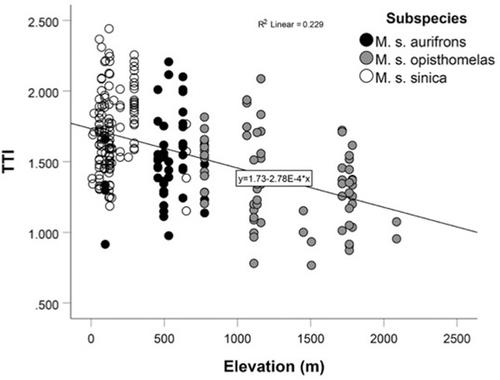当前位置:
X-MOL 学术
›
Am. J. Primatol.
›
论文详情
Our official English website, www.x-mol.net, welcomes your
feedback! (Note: you will need to create a separate account there.)
What makes a long tail short? Testing Allen's rule in the toque macaques of Sri Lanka.
American Journal of Primatology ( IF 2.0 ) Pub Date : 2020-02-24 , DOI: 10.1002/ajp.23113 Michael A Huffman 1 , Raveendra Kumara 2 , Yoshi Kawamoto 3, 4 , Prasad M Jayaweera 5 , Massimo Bardi 6 , Charmalie A D Nahallage 2
American Journal of Primatology ( IF 2.0 ) Pub Date : 2020-02-24 , DOI: 10.1002/ajp.23113 Michael A Huffman 1 , Raveendra Kumara 2 , Yoshi Kawamoto 3, 4 , Prasad M Jayaweera 5 , Massimo Bardi 6 , Charmalie A D Nahallage 2
Affiliation

|
Allen's rule (1877) predicts ecogeographical anatomical variation in appendage proportions as a function of body temperature regulation. This phenomenon has been tested in a variety of animal species. In macaques, relative tail length (RTL) is one of the most frequently measured appendages to test Allen's rule. These studies have relied on museum specimens or the invasive and time-consuming capturing of free-ranging individuals. To augment sample size and lessen these logistical limitations, we designed and validated a novel noninvasive technique using digitalized photographs processed using LibreCAD, an open-source 2D-computer-aided design (CAD) application. This was used to generate pixelated measurements to calculate an RTL equivalent, the Tail to Trunk Index (TTI) = (tail [tail base to anterior tip] pixel count/trunk [neck to tail base] pixel count). The TTI of 259 adult free-ranging toque macaques (Macaca sinica) from 36 locations between 7 and 2,087 m above sea level (m.a.s.l.) was used in the analysis. Samples were collected from all three putative subspecies (M. s. sinica, aurifrons, and opisthomelas), at locations representing all altitudinal climatic zones where they are naturally distributed. These data were used to test whether toque macaque tail length variation across elevation follows Allen's rule, predicting that RTL decreases with increasing elevation and lower temperature. Our results strongly supported this prediction. There was also a statistically significant, negative correlation between elevation and annual average temperature. The best predictor for the TTI index was elevation. Significant subspecies differences in RTL are linked in part to their ecological and altitudinal niche separation, but overall the variation is seen as the species' adaptation to climate. The method developed for the quick morphometric assessment of relative body proportions, applicable for use on unhabituated free-ranging animals, widens the range of materials available for research studying morphological characteristics and their evolution in primates.
中文翻译:

是什么让长尾巴变短?在斯里兰卡的无边猕猴中测试艾伦的法则。
艾伦(1877)的规则预测,肢体比例的生态地理解剖变化是体温调节的函数。这种现象已在多种动物物种中得到测试。在猕猴中,相对尾巴长度(RTL)是测试艾伦法则的最常测量的附件之一。这些研究依赖于博物馆标本或自由放养的个体的侵入性和耗时的捕获。为了增加样本量并减少这些后勤限制,我们设计并验证了一种新颖的非侵入性技术,该技术使用了使用开源2D计算机辅助设计(CAD)应用程序LibreCAD处理的数字化照片。这用于生成像素化测量值以计算RTL等效项,尾巴至躯干指数(TTI)=(尾巴[尾巴至前尾]像素数/尾巴[颈至尾巴]像素数)。分析中使用了来自海拔7到2087 m之间的36个位置的259只成年自由放养的短尾猕猴(Macaca sinica)的TTI。在代表自然分布的所有海拔气候区的位置,从所有三个假定的亚种(中华绒螯蟹,aufronons和opisthomelas)收集样品。这些数据被用来检验猕猴的尾巴长度在整个海拔高度上的变化是否遵循艾伦的规则,预测RTL随着海拔的升高和温度的降低而降低。我们的结果强烈支持了这一预测。海拔和年平均温度之间也存在统计上显着的负相关。TTI指数的最佳预测指标是海拔。RTL的显着亚种差异部分与它们的生态位和海拔位生态位分离有关,但总的来说,这种变化被视为该物种对气候的适应。该方法可用于相对体比例的快速形态计量评估,适用于无栖息地的散养动物,拓宽了可用于研究灵长类动物形态特征及其进化的材料范围。
更新日期:2020-04-13
中文翻译:

是什么让长尾巴变短?在斯里兰卡的无边猕猴中测试艾伦的法则。
艾伦(1877)的规则预测,肢体比例的生态地理解剖变化是体温调节的函数。这种现象已在多种动物物种中得到测试。在猕猴中,相对尾巴长度(RTL)是测试艾伦法则的最常测量的附件之一。这些研究依赖于博物馆标本或自由放养的个体的侵入性和耗时的捕获。为了增加样本量并减少这些后勤限制,我们设计并验证了一种新颖的非侵入性技术,该技术使用了使用开源2D计算机辅助设计(CAD)应用程序LibreCAD处理的数字化照片。这用于生成像素化测量值以计算RTL等效项,尾巴至躯干指数(TTI)=(尾巴[尾巴至前尾]像素数/尾巴[颈至尾巴]像素数)。分析中使用了来自海拔7到2087 m之间的36个位置的259只成年自由放养的短尾猕猴(Macaca sinica)的TTI。在代表自然分布的所有海拔气候区的位置,从所有三个假定的亚种(中华绒螯蟹,aufronons和opisthomelas)收集样品。这些数据被用来检验猕猴的尾巴长度在整个海拔高度上的变化是否遵循艾伦的规则,预测RTL随着海拔的升高和温度的降低而降低。我们的结果强烈支持了这一预测。海拔和年平均温度之间也存在统计上显着的负相关。TTI指数的最佳预测指标是海拔。RTL的显着亚种差异部分与它们的生态位和海拔位生态位分离有关,但总的来说,这种变化被视为该物种对气候的适应。该方法可用于相对体比例的快速形态计量评估,适用于无栖息地的散养动物,拓宽了可用于研究灵长类动物形态特征及其进化的材料范围。











































 京公网安备 11010802027423号
京公网安备 11010802027423号